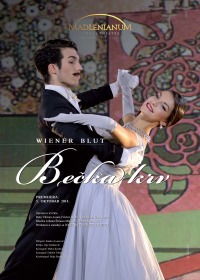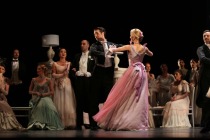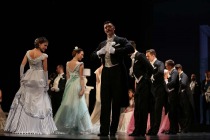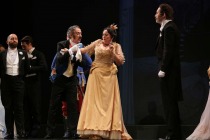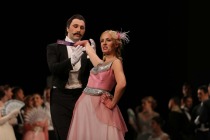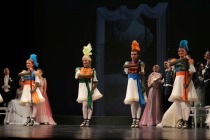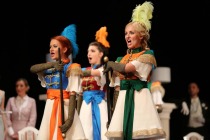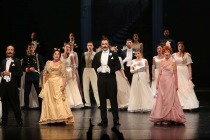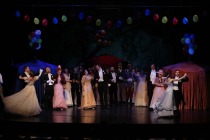Johann Strauss II
WIENER BLUT
Book & Buy Tickets5. October 2014
Large Stage od Madlenianum
Conductor: Stanko Jovanovic
Director: Voja Soldatovic
Choreographer: Mirko Knezevic
Set Designer: Dalibor Tobdzic
Costume Designer: Maja Studen
Lightning Designer: Srdjan Jovanovic
Translater: Husnija Kurtovic
Cast: Nenad Nenić/Ivan Plazačić, Ljubomir Popović/Vanja Biserčić, Tanja Obrenović/Nataša Tasić Knežević, Milan Milosavljević, Branislava Podrumac/Olga Malević Đorđević, Ivan Bekjarev, Senka Nedeljković/Aleksandra Jovanović, Goran Strgar/Marko Živković
Madlenianum Opera & Theatre Orchestra
Nevena Đorđević, Irina Dragojević, Marijana Radosavljević, Milica Marjanović, Milica Stojčev, Aleksandra Anđelković, Maja Tomašević, Svetlana Krstić, Jovana Ćirić, Danica Andrić, Jovana Bijelić, Jovana Jovićević, Zorana Stanišić, Bojan Dragojević, Srđan Mladenović, Boris Balunović, Nikola Piperski, Ivan Debeljak, Igor Andrić, Momčilo Radojević, Svetozar Vujić, Vladimir Bulatović, Andrija Nikoletić, Marko Pantelić
Choir preparation: Biserka Vasić
Dance Ensemble:
Marija Martinović, Jelena Borović, Vanja Vasiljević, Katarina Obradović, Irena Maksimović, Ignjat Filipović, Marko Vasiljević, Vukašin Prvulović, Boško Graovac, Luka Bugarin
Wiener Blut (Vienna Blood) operetta was first performed on 26th of October 1899 in Vienna, four months after the death of Johan Strauss Jr. The operetta was commissioned by Franz Jauner, the manager of Carl Theatre.
The idea behind the operetta, the title of which was taken from one of Strauss’ s most popular waltzes (Wiener Blut Op. 354), was for the creation of a stage work that made use of melodies from Strauss’ older and less known works. Music was selected and arranged by Adolf Müller Jnr., the house conductor of Theater an der Wien. Jauner had high hopes for the operette Wiener Blut and staged a lavish production, but the first night was a complete fiasco and athe production closed after only thirty performances. Bankrupted by this failure, Jaunert shot himself.
In 1905, with a slightly adjusted book and score, Wiener Blut was revived at the Theater an der Wien, where it was a success. It entered the repertoire of the Vienna Volksoper in 1928, where it has remained ever since.
Wiener Blut is set at the time of the Congress of Vienna, 1814-1815, an international conference that sought to settle Europe after the upheavals of the Napoleonic Wars, and follows a traditional operetta plot full of mistaken identities.
Count Balduin Zedlau, ambassador of the tiny court of Reuss-Schleiz-Greiz, is posted to Vienna. Although married to Gabriele, the Count is having affairs with both the ballerina Franzi and the model Pepi. Pepi in turn is engaged to his valet Josef. Zedlau’s attempts to keep all his relationships in balance at the same time results in confusion, which is made even more chaotic through the involvement of the aged but amorous Prime Minister.
After much intrigue, many misunderstandings, and numerous false identities, Zedlau realises that his heart belongs to Gabriele, who generously forgives him for his numerous amatory indiscretions.
This operetta has never been on repertoires in our country, which makes the premiere in Opera and theatre Madlenianum, the first night in Serbia at the same time.
In front of ourselves, we will find XIX century Vienna in its full splendor, frivolity, easiness and beauty, along with its hypocrisy. At the stage, we may see a parade of princes and counts in a sort of a love thriller, with the count as a center of a love action, and his wife and two mistresses, in whirlpool of good music, combine old and new loves drowning into Viennese spirit and Vienna Blood which gives a special charm to all of that. The most popular polkas, gallops and waltzes can be heard and the participants dance, drinking sparkling champagne and “It is the Viennese waltz that gives joy and splendor to the ball”. The thriller stays unresolved until the very end, and the light play with a lot of dance, good music and laugh seems humorous. Luxury, cheating, intrigues, falling in love and joy of life are the drops of Viennese blood, owned only by Viennese people and recognized from far away.
Transferring the real Viennese atmosphere of past centuries to Belgrade is a big challenge, especially because operetta as a genre is not so frequent on the stages in our country. Although everything seems light and swaying, the requests put in front of the participants suppose high singing level and the same level of acting abilities, because operetta consists of extensive spoken parts as well as series of arias, duets and ensembles. The score of Wiener Blut supposes inflamed and accelerated tempos, with the perfected precision of all the parts of the big ensemble which consists of, on the first place, lavish orchestra, choir, a group of dancers and a list of singers and actors. In such jagged team, fitting all the elements into the whole as well as their mutual and tight pervasion bring the success of the staging.
The scene and costumes are supposed to evoke the atmosphere of shining Viennese salons, villas, booths and casinos, and all of that in a naïve play game with the task to entertain, make laugh and offer pleasure. Well-known melodies and music we listen to at the New Year’s concerts broadcasted from Vienna bring us even closer to the environment that has been geographically, socio- economically, as well as musically very close to us during all the previous centuries.

